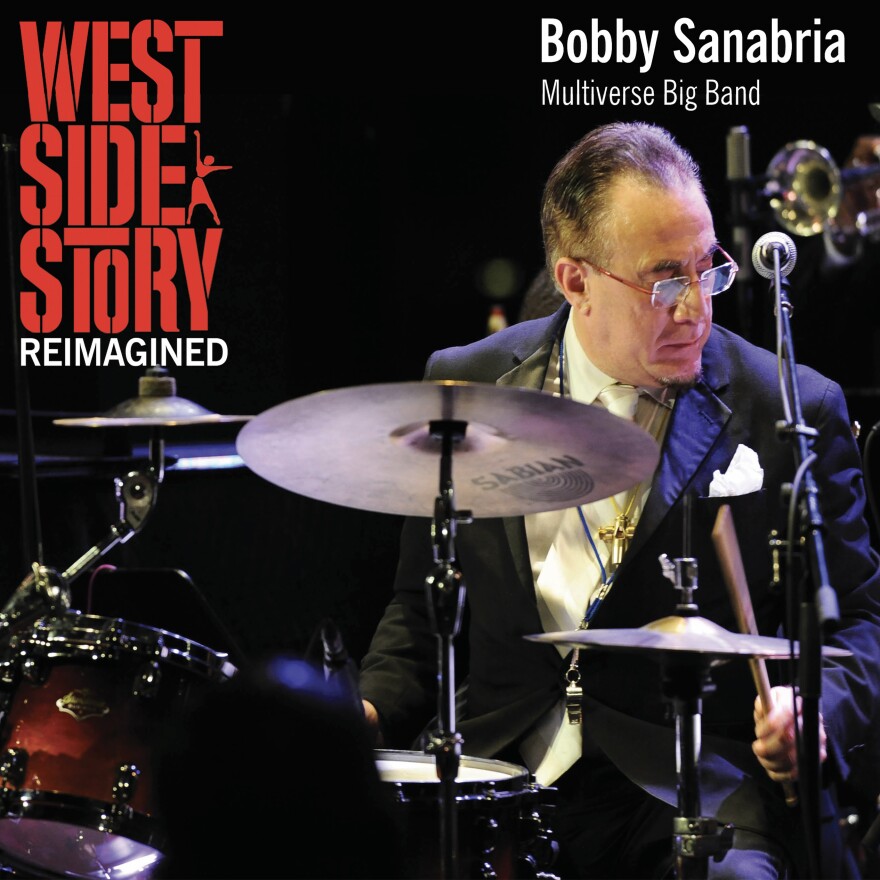Bobby Sanabria Multiverse Big Band, “Somewhere”
Leonard Bernstein’s progressive musical West Side Story is having a moment. Steven Spielberg has been casting a highly anticipated new film adaptation, with a script by Tony Kushner — and just last week, a new Broadway production was announced, with director Ivo van Hove and choreographer Anne Teresa De Keersmaeker. In the mist of all this clamor comes West Side Story Reimagined, a new album by drummer-bandleader Bobby Sanabria, releasing this Friday on Jazzheads.
Sanabria grew up admiring the first film version of West Side Story, which he took as a validation of Puerto Rican culture in New York. “At that time there wasn’t anything that acknowledged the contributions we had made,” he recalls in the liner notes, adding that “when I first heard the music I was flabbergasted.” Last fall, to commemorate the 60th anniversary of West Side Story’s original Broadway premiere, Sanabria brought his Multiverse Big Band to Dizzy’s Club Coca-Cola to play all-new arrangements of the score. More authentic in its cultural footing than some other jazz versions, like the medley made famous by Buddy Rich, it’s a love letter to Bernstein as well as a reclamation, tracing his evocation back to the source.

This version of “Somewhere,” the great yearning love song at the heart of the matter, has one foot in the heyday of the Palladium Ballroom and another in the punchy modernism of a band like the Thad Jones-Mel Lewis Orchestra. It also has a compelling electric violin solo by Ben Sutin, and some potent work from the first trumpeter, Kevin Bryan. (Sanabria will play a free show with his band Ascensión at the Newark Museum on July 26; the Multiverse Big Band will perform West Side Story Reimagined at Damrosch Park, as part of Lincoln Center Out of Doors, on Aug. 10.)
Chris Lightcap Superette, “Djali”
Bassist and composer Chris Lightcap has a glowing track record as a solo artist, almost entirely with the group he calls Bigmouth, featuring Tony Malaby and Chris Cheek on tenor saxophones. The instrumentation and aim are quite different in Lightcap’s new band Superette, which has a self-titled album due out on Royal Potato Family in September. Rather than a postbop unit anchored by acoustic bass, it’s a guitar-centric proposition with a layered approach to groove.
Lightcap plays electric bass in the band, which has Jonathan Goldberger and Curtis Hasselbring on electric guitars and Dan Rieser on drums. (The album also includes cameos by Nels Cline, yet another guitarist, and John Medeski, on organ.) “Djali,” which has its premiere here, nicely encapsulates the radiant energy in the band, and the canny way in which Lightcap deploys his resources. The obvious debt to West African pop traditions here cohabits with elements of shimmery surf-rock and gnarly jazz fusion. It’s intrepid stuff — but more importantly, it moves.
Pete McCann, “Pay For It On the Other Side”
Pay For it On the Other Side, the smartly assured new album by guitarist Pete McCann, covers a broad expanse of style — from Mahavishnu-esque jazz-rock (“Nikhil”) to skronky second line (“Mud Flap”) to pastoral reverie (“Yonder”) — but never with a feeling of empty eclecticism, or the sense of someone checking off items on a to-do list. McCann, who has been an interesting composer and improviser at least since his debut album 20 years ago, brings deep curiosity and abiding focus to this session, with alto saxophonist John O’Gallagher, pianist Henry Hey, bassist Matt Clohesy and drummer Mark Ferber.

The title track — inspired both by McCann’s routine traverse of the George Washington Bridge and some deeper implications of the afterlife — is a kinetic piece set at a forward tilt. Swerving between a syncopated prog energy and a slaloming swing feel, it brings out some expert work by every member of the band, notably in back-to-back solos by McCann and O’Gallagher, whose rapport is a steadfast feature of the album as a whole.
Norah Jones, “It Was You”
Norah Jones is up to something. Last month she surprise-released “My Heart is Full,” a socially conscious ballad with a low, throbbing rhythm. A few days ago she followed it with a more characteristic song called “It Was You.” Musically the track strikes a balance between modern jazz and Memphis soul, with Jones and her regular cohort — Brian Blade on drums, Christopher Thomas on bass, Pete Remm on organ — joined by trumpeter Dave Guy and tenor saxophonist Leon Michels.
Together they create a sound largely contiguous with Day Breaks, Jones’s soul-stirring version of a jazz album from 2016. According to Blue Note, this new music is a result of Jones “following her muse down creative pathways without any expectations or boundaries.” Which could mean that no new album is immediately forthcoming. Or the opposite. The song itself harbors no such ambivalence; consult the chorus, which consists of a single repeated line.
Yussef Dayes & Alfa Mist feat. Mansur Brown, “Love is the Message”
A central figure in the ongoing eruption of unmissable young talent from London, Yussef Dayes is best known as the drumming half of groove-minded outfit Yussef Kamaal. Last week Dayes released his first single as a solo artist, working with keyboardist Alfa Mist and guitarist Mansur Brown. The track, “Love is the Message,” suggests a glorious convergence of slow-drag CTI funk and dreamy psychedelic rock, with hip-hop as the invisible binding constant. Its full running time goes by in a flash, but just in case you’re in a hurry, be sure to hang around long enough to hear Brown make his entrance as a soloist, just over four minutes in.



